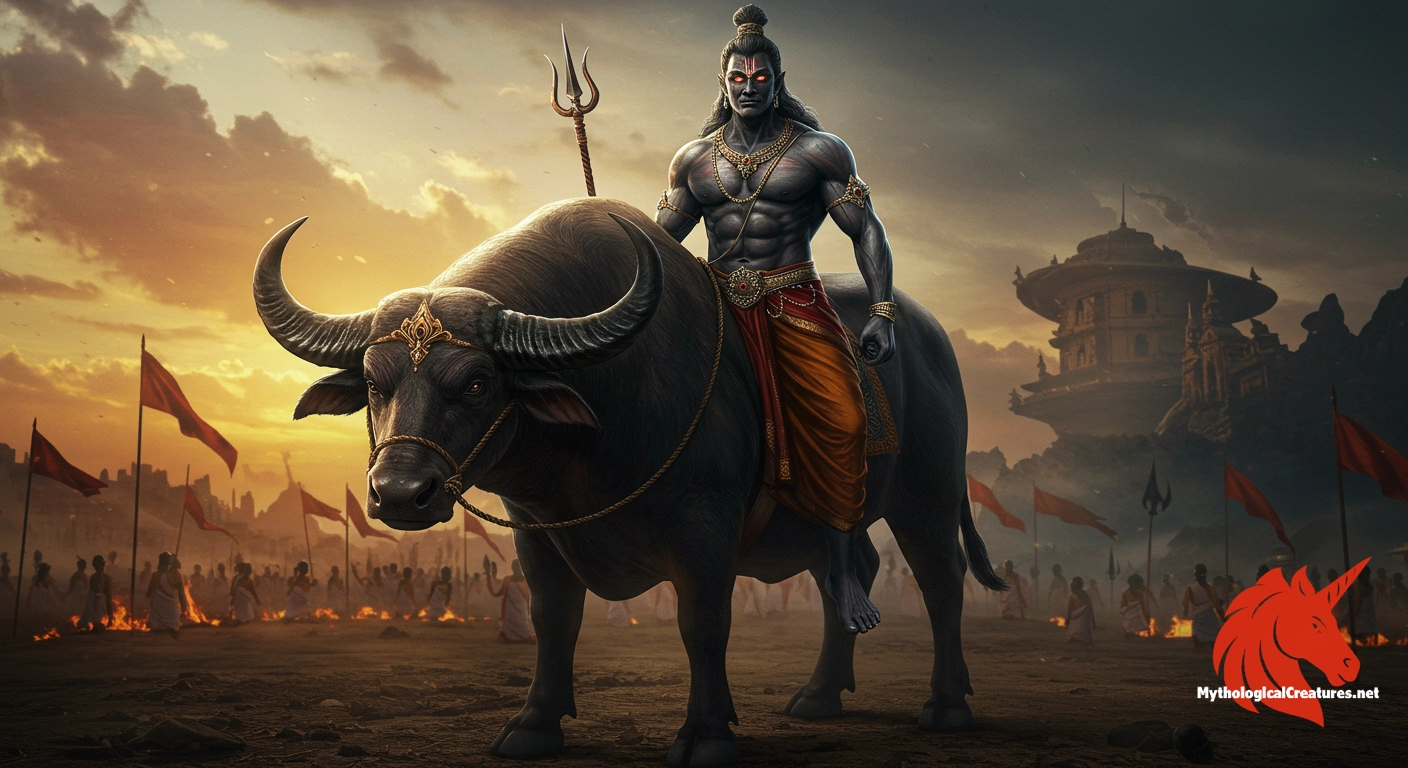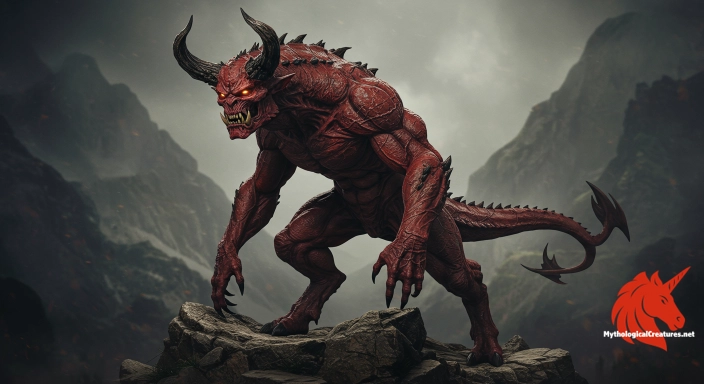Yama: Yama is the Hindu god of death and justice, responsible for the judicious dispensation of law and punishment in the afterlife.

Yama
Yama - Yama plays a crucial role in maintaining cosmic balance by ensuring that every soul receives its just reward or punishment in the afterlife.
Origins & First Encounters
Yama emerges as one of the most compelling figures in Hindu mythology, presiding over the realm of death with unwavering authority and moral precision. Born from ancient Vedic traditions, his origins are shrouded in the early narratives where he is celebrated as the first mortal to have experienced death. His dual appellations as Kala and Dharmaraja underscore both the inevitability of demise and the profound principle of dharma that guides moral conduct. The multifaceted deity not only administers the dispensation of law but also punishes souls according to their earthly deeds. His legendary role as a judge of the dead forms a central theme in several seminal texts, ranging from the Upanishads to the epic narratives of the Ramayana and Mahabharata. Rooted in an era when life and death were interwoven with cosmic order, Yama symbolises the eternal balance between reward and retribution. His cultural significance is further enhanced by his mythological connection with Yami, enriching his persona through familial bonds and dualistic symbolism. Over time, his character has come to represent not merely an end but the transition to a new beginning, reflecting the cycle of rebirth and karmic justice. Yama’s timeless appeal endures, captivating those who seek to understand the intricate relationship between divine judgment and human morality.
Source Texts & Tale Variants
Ancient scriptures provide a rich tapestry of narratives where Yama’s character is woven with intricate detail and allegory. In the Vedic texts, his story is introduced as that of the first human to experience death, setting the stage for his later role as the arbiter of souls. Various Upanishads expand on his duties, painting him as both a compassionate guide and a stern judge in the afterlife. The epic literature, including the Mahabharata and Ramayana, further elaborate on his responsibilities in assigning souls to their rightful destinies, be it the realms of Naraka or rebirth on earth. The Puranic texts present diverse versions of his myth, each adding layers of symbolism that underscore his judicial capabilities. Beyond the strictly Hindu canon, Yama’s narrative is echoed in lesser-known folk traditions and regional tales that explore the nature of death and cosmic justice. Buddhist texts later adapted his image as Yama Raja, incorporating him into their own elaborate afterlife cosmologies. His story resonates in these ancient narratives not only as a mythological account but also as a didactic expression of moral order, where every sin and virtue is ultimately acknowledged. The multiplicity of sources opens a window into the enduring dialogue between destiny, ethics, and the inevitable fate that awaits every soul.
Form & Powers
Yama is traditionally depicted as a formidable figure with a dark, almost somber complexion that reflects the profound mysteries of death. His appearance is marked by a commanding presence, with a physique that is both robust and majestic, symbolising the strength required to uphold the cosmic order. Often shown riding a mighty buffalo, his steed reinforces the imagery of both primal power and an unyielding connection to nature. In artistic renditions from different eras, his eyes are portrayed as deep and penetrating, conveying the weight of eternal judgment. The noose or mace he carries is not merely an accessory but a potent emblem of his authority to capture wandering souls. Decorative crowns and regal ornaments accentuate his status as the sovereign of the realm of the dead. Variations in his iconography sometimes include detailed patterns on his garments, suggesting the delicate balance between the physical and the metaphysical. Although his form can shift subtly according to regional artistic styles, every portrayal reinforces his austere yet fair governance over life and death. The careful attention to his attributes encapsulates both the inevitability of fate and the precision of divine justice.
Regional Faces
Across various regions in Asia, the depiction of Yama has been adapted to reflect local cultural nuances and aesthetic sensibilities. In India, traditional portrayals remain rooted in ancient texts, yet regional art often embellishes his figure with specific local motifs that speak to the community’s unique worldview on death. In Chinese, Japanese, Korean, and Tibetan traditions, Yama’s character is reinterpreted while retaining his core function as the ruler of the afterlife. These adaptations often involve a shift in iconography; for instance, his attire may mirror indigenous styles, and his expression might convey a more bureaucratic or even compassionate tone compared to the stark Hindu images. In Japan, the figure of Enma, inspired by Yama, carries distinct features that integrate local folklore with Buddhist ideals. Tibetan interpretations sometimes blend Yama with native protective deities, thereby expanding his mythological role within a broader spiritual context. Local narratives also colour his persona, with some communities emphasising his compassionate aspects while others highlight the fearsome power of his judgment. Despite these differences, the universal theme of moral retribution connects all versions, underscoring a shared human preoccupation with justice and mortality. These regional reinterpretations illustrate the fluidity of myth, where a single deity can bridge disparate cultural landscapes.
Cultural Parallels
When examining Yama alongside other mythological figures, striking parallels can be drawn that illuminate a universal need to confront the mystery of death. The Greek god Hades comes to mind, as both deities preside over realms that govern the fate of souls, albeit Hades’ role lacks the pronounced moral enforcement seen in Yama. Similarly, Norse mythology presents Hel, who governs a separated domain of the dead, reflecting comparable themes of inevitability and divine justice. Even in Egyptian mythology, Osiris embodies the process of death and resurrection, carrying an echo of Yama’s transformative function in the cycle of life and afterlife. In many East Asian traditions, the figure of Enma serves as a direct cultural descendant of Yama, integrating similar judicial duties with an emphasis on moral balance. These comparative studies reveal that societies across the globe construct deities that not only manage the finality of life but also articulate the moral consequences of earthly behaviour. While stylistic and narrative differences exist, the archetype of a divine judge is a recurring motif that speaks to a collective understanding of life's inherent uncertainties. These cultural parallels offer a fascinating insight into the shared human endeavour of making sense of mortality, justice, and the inexorable passage between worlds.
Legacy & Modern Evolution
The evolution of Yama’s portrayal from ancient scripture to modern cultural iconography reflects a rich tapestry of historical reinterpretation and creative adaptation. Over the centuries, his image has transformed from a fearsome adjudicator of souls into a symbol that bridges the ancient and the contemporary. In the medieval era, artistic depictions began incorporating more nuanced elements, blending fierceness with a hint of compassion to reflect the complex nature of death. This evolution continued as Buddhist traditions absorbed and redefined his role, reinforcing his authority while simultaneously imbuing him with a broader cosmological significance. In modern times, Yama’s visage has found a novel application in public safety campaigns and popular media, where his stern countenance is employed to instil a sense of respect for life and discipline. Contemporary artists and writers often reimagine his narrative to address modern existential concerns, exploring themes of fate, judgement, and the enduring mystery of the human condition. His legacy is not static but is continually reshaped by cultural dialogue, reflecting evolving attitudes towards mortality and ethics. Today, Yama remains a potent symbol that transcends the boundaries of myth and ritual, compelling modern audiences to ponder the universal realities of justice and the inevitable cycle of life and death.
Interesting Fact
An intriguing aspect of Yama is that he is celebrated as both the first mortal to die and as an eternal, immortal god, encapsulating a unique duality in mythological narratives.
Quick Creature Info
Associations:
Our Mythic Legendary Rating:

Also Sometimes Known As:
Habitat:
Supernatural Powers:
Physical Attributes:
Abilities:
Behavior:
Lore:
References
Discover Another Mythical Legend You May Not Have Heard Of?
Uncover the mysteries of ancient folklore and expand your knowledge of legendary beings from cultures around the world.
Dare to Meet the Mazoku....
Mythical Disclaimer: The images and data on this site are derived from various historical and literary sources, but we have found that many myths often have multiple versions and interpretations across references, sometimes contradictory. As a result, these creature depictions are artistic interpretations—imaginative blends of folklore, legend, and a dash of AI guesswork. Because creature descriptions vary widely, our illustrations and accompanying information represent our best effort to honor mythology while bridging creative gaps. Enjoy these interpretations—just remember, we've done our best to respect the stories and validate available data, but in the realm of mythology, details often shift, imagination leads the way, and nothing is ever set in stone!
Curated by the Mythological Creatures Team (rev. May 2025)
